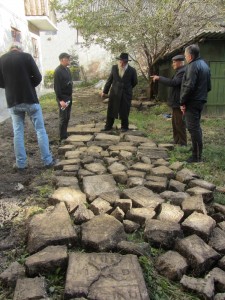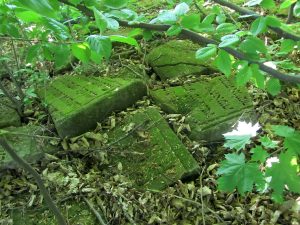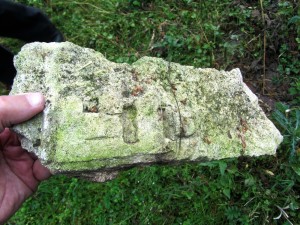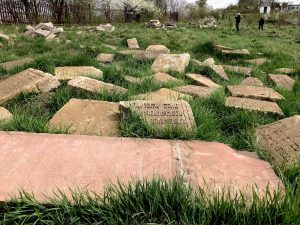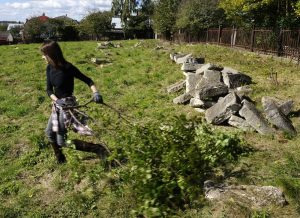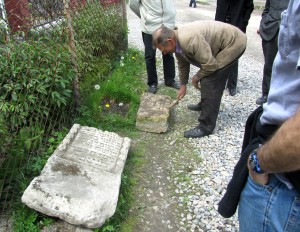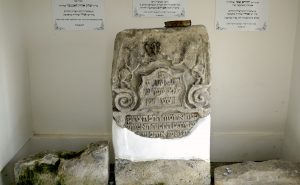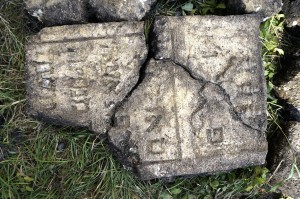![]() Ця сторінка також доступна українською.
Ця сторінка також доступна українською.
Introduction
For the most part, the Jewish headstones (grave markers, tombstones, matzevot) of Rohatyn are not where they should be: decorating the Jewish cemeteries and marking the burial places of the individuals and families they were meant to commemorate. With few exceptions, this particular Jewish heritage of Rohatyn can hardly be called “immovable”, and it isn’t possible for this page to link to GPS coordinates of its locations, as other heritage pages here do.
Although the displacement of nearly all the headstones from the Jewish cemeteries during and after WWII is tragic, the gradual recovery of their surviving fragments from the streets, walkways, riverside, and building foundations in Rohatyn, and their return to the cemeteries from which they were taken, has created a growing collection of stones and an open-air visual archive of the pre-war Jewish community. The recovery process has also created opportunities for cross-cultural understanding and cooperation in Rohatyn. Today there are standing and recovered headstones in both of Rohatyn’s Jewish cemeteries.
The efforts to recover and return Jewish headstones to the cemeteries have been made over the past few decades by survivors of the Rohatyn Jewish ghetto, other Jewish descendants, and Rohatyn townspeople – especially retired teacher and local historian Mykhailo Vorobets. That effort accelerated with the engagement of Rohatyn Jewish Heritage in 2011, and has been active with progress every year since then.
Read about the Jewish Headstone Recovery Project
This article is part of a series on Rohatyn’s Jewish heritage on this website. To view the headstones and cemeteries as part of the broader Jewish heritage of the town and the district, see this modern interactive map of the heritage sites.
A Brief History of the Headstones
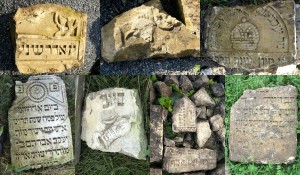
A small sample of the many matzevot styles among recovered stones in Rohatyn.
Photos © 2011, 2012, 2014 RJH.
As described in our article on Jewish cultural traditions surrounding the end of the life cycle (death, burial, and mourning), cemeteries have held a high position in Jewish religious life for millennia, and generally are regarded as holy places more sacred than prayer houses. A Jewish funeral is a symbolic farewell to the deceased. Although there is no Jewish law which prescribes the placement of marker at a grave, matzevot typically made of wood or stone have been part of European Jewish cemetery tradition for more than a thousand years. By the time Jews settled in Rohatyn four centuries ago, figurative art had begun to appear on headstones, complementing the often poetic epitaphs with symbolism and decoration. The practice of honoring the dead with carved words and pictures at their grave continued in Rohatyn until the Shoah and the end of Jewish life in town.
The German occupation of Rohatyn which began in 1941 meant not only the concentration of Jews into a ghetto, deportations, and violent death in mass shootings, but also the destruction of Jewish material culture in town. At some point during the war, laborers toppled the Jewish headstones in the cemeteries, broke the stones into large fragments so they could be carried, and carted the stones away. The stolen stones were used as ordinary building material in Rohatyn, to make a load-bearing layer for roads and sidewalks, to strengthen the banks of the Hnyla Lypa river, to support vehicles in parking areas, and to make the foundations of newly-constructed buildings. Many decades later, elderly Ukrainian residents of Rohatyn remembered the exploitation of the headstones in town: [T]here had been a large [cemetery], with one gravestone after the next, tall, made of stone. Later the Germans took these gravestones and made them into sidewalks. They built sidewalks, roads. [Yahad – In Unum witness YIU/2092U, 1:27:01] After the war, she recalled that where roadside walkways were paved with Jewish headstones, some older people in town refused to walk on them, as they considered to do so a sin. [Yahad – In Unum witness YIU/20195U, 2012 interview with RJH]
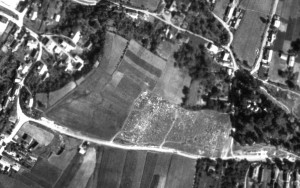
German military aerial photograph from 27 June 1944; original image in the US National Archives Cartography Department; copy acquired by Dr. Alex Feller.
The wartime destruction of Rohatyn’s Jewish cemeteries is hardly unique. The Nazi campaign may not have been systematic or complete in Central Europe, but it was determined and extensive, and few cemeteries survived mostly intact; damage was particularly severe in smaller towns and in older cemeteries, especially in eastern Galicia. The theft of broken Jewish headstones and the near-leveling of cemeteries occurred under German occupation and subsequent Communist rule [USCPAHA Ukraine report 2005]. Thus, even Jews already dead and buried before the war did not escape the devastation of the Shoah, and the attempt to erase all memory of them nearly succeeded.
Like 40% of the Jewish cemeteries surveyed in modern Ukraine by the USCPAHA, the cemeteries of Rohatyn each have fewer than 20 surviving matzevot, not counting the loose stones now being recovered. While the new Jewish cemetery in Rohatyn had begun service less than two decades before WWII, the old cemetery had served the community for centuries. An estimate of the number of headstones or stumps in Rohatyn’s densely-filled old Jewish cemetery, made from analysis of a 1944 Luftwaffe aerial photograph, suggests well over a thousand large stones once stood there; the pre-war Jewish population of Rohatyn and long history of the community there support a much larger estimate of original headstone numbers, likely several thousand.
Surviving Fixed Jewish Headstones
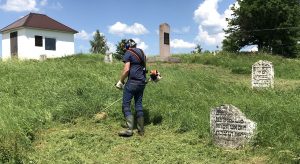
Clearing the old cemetery grounds around four standing historic headstones, a post-war memorial stele, and the closed ohel. Photo © 2019 RJH.
Barely a dozen fixed and upright headstones, horizontal grave covers, or other permanent markers of pre-war burials remain at Rohatyn’s first or “old” Jewish cemetery. A few of the upright matzevot are intact with legible epitaphs; most of the stones have suffered some damage, and some are missing most of their original form. One large enclosed ohel was constructed at the top of the cemetery in 2011 over three grave covers of highly-regarded Rohatyn and Stratyn rabbis from the 19th century; a small open ohel was erected behind a fixed headstone in 2017.
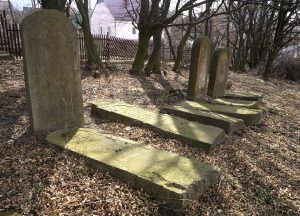
The three standing headstones in the new cemetery, together with several of the fallen or recovered stones. Photo © 2019 RJH.
According to its epitaph, the oldest legible standing headstone in the old cemetery dates from 1741, and was erected over the grave of Rabbi Elisha, son of Rabbi Yehoshua more than 275 years ago. Today the stone is painted white with black lettering, but a photo from more than 15 years ago shows the stone prone and without paint. We have no information about this, but it seems likely that several or perhaps all of the stones currently standing in the old cemetery were moved there and raised some time after the war.
The second or “new” Jewish cemetery in Rohatyn still has three complete and upright headstones, as well as several complete headstones which were uprooted and now lay down on the cemetery grounds, either near their likely original graves or at random locations within the cemetery boundaries.
All of the standing stones in the old and new cemeteries have been photographed and documented online in a temporary image database managed by the Rohatyn District Research Group (RDRG), accessible at the link below. A few fragmentary fixed stones (stumps) have been discovered in cemetery clearing events in recent years and are not yet online.
Displaced Jewish Headstones and Fragments
As described above, nearly all of the headstones which once stood in the Jewish cemeteries are now hidden underground and under buildings around town, mostly in fragments; a small fraction of the original number of headstones has been recovered. At least two dozen fragmented and intact headstones were recovered and moved to the new Jewish cemetery some time after Ukraine’s independence by laborers working for local historian Mykhailo Vorobets with the support of aging Jewish survivors of Rohatyn’s wartime ghetto including Boris Arsen in Ivano-Frankivsk and Fischel Kirschen in Israel; there are no records indicating from where those stones were recovered. Since 2011, with the aid of Mr. Vorobets, Rohatyn Jewish Heritage has organized the recovery of more than five hundred additional fragments and one large and complete headstone; on the advice of the Rabbi of Ivano-Frankivsk, those stones have all been returned to the old Jewish cemetery. RJH estimates that perhaps ten times that number still remain under streets and walkways and buildings in Rohatyn.
The discovery of buried headstone fragments is usually accidental: city or utility workers digging in a street find stones used as structural materials; private citizens digging in their gardens or to make the foundation of a fence uncover one or dozens of stones; shifting banks of the city’s creek and river unearth stones placed there long ago; dismantling an old building reveals headstones used as a foundation, wall, or stairway.
As seen in the map of headstone recovery locations below, there are patterns of discovery based partly on city and utility work schedules, and partly on the wartime use of the stones as building material on major roads and access routes to important service points. One small area of Rohatyn to the northeast of the town square today forms a courtyard, parking area, and private garden; according to Mr. Vorobets, during WWII the place was used as parking for a Gestapo building in front. This one area has already yielded more than a hundred Jewish headstone fragments (in 2011, 2012, 2014, and 2019), and local people believe it will yield many more whenever the ground needs to be opened there.
What is the contemporary value of a displaced matzevah? Or a fragment of one? And if there is too little surviving text on it to ever enable pairing the stone with the person it memorializes? What is the point of moving the stone or fragment back to its cemetery of origin, if we cannot precisely locate wherein it belongs, and if that cemetery can never be “repaired” or “restored”? These broken headstones are not quite immovable heritage, nor are they exactly intangible heritage (though images of their designs and script can contribute to that). What should be done with the heavy stones?
Rohatyn Jewish Heritage believes that one headstone, even a fragment, can do as much as a rare photograph to evoke an individual Jewish citizen who lived and died in Rohatyn or the surrounding villages before the Second World War. A single recovered stone or fragment is a curiosity, but a collection of recovered stones begins to represent the past Jewish community of Rohatyn, and the variety of designs, symbols, and epitaphs on the stones give visual clues to the diversity of Jewish life in the area before the devastation of the war erased nearly all other records of that life. We believe as well that the recovered stones enhance the power of the Jewish cemeteries as places of memory (lieux de mémoire) for Rohatyn, its residents and its visitors; the stones help to create meaning, and to spark questions of who and why and how.
There is great value in these stones, both for Jewish descendants of the deceased they represent and for current residents of Rohatyn, in the processes of uncovering, extracting, transporting, cleaning, reading, and setting the stones in a more fitting place. If at first glance even the gathered stones seem like rubble, the care with which people treat the pieces confirms that these stones have a place in the heritage of the town.
We have seen repeatedly, in more than 50 visits to Rohatyn to support this project, that the townspeople are more than curious about the project; they want to help, and they see this as an opportunity to show respect for the memory of those who once lived there. Some approach us in the street with information about the locations of stones; others watch as we record new discoveries, or help us clean the stones; some just quietly observe, or hold our hands while the work proceeds. And always there is discussion; the older people remember, and the younger ones listen. Our public work around town is probably the first exposure many of the youngest residents have had to the once-thriving Jewish community of Rohatyn; that provides us with an opportunity to represent the many who are missing, by returning and remembering.
The matzevot in Rohatyn deserve this care; each of them is an heirloom, and they have important stories to tell. Over more than eight years of recovery work, we have encountered stones of great beauty, and some which once stood over the graves of known historical figures. While working on vul. Zelena in 2012, we found several large stones which had been unearthed by sewer work under the road. Even caked with mud, the image of a lion and some writing was visible. As washing and scrubbing continued in the evening, the full design became clearer, revealing a second lion, a crown, and more script. Returning the next morning, translation of the text revealed that the stone belonged to a prominent rabbi in Rohatyn. The stone was transported to the cemetery, and then a Hasidic group returned this stone to its place in a new ohel built over three graves of rabbis in the old Jewish cemetery, as the first reconnected stone since the war.
Nearly two hundred of the recovered headstone fragments now resting in the old Jewish cemetery have been photographed and documented online in a temporary image database managed by the Rohatyn District Research Group (RDRG), accessible at the link below.
We realize that ongoing decay and disintegration of the surviving headstones is natural and inevitable; the stone materials from which nearly all the recovered matzevot are made is very soft. These stones would also have decayed normally had they stood in the cemeteries for the past 75 years. Rohatyn Jewish Heritage project plans include recording what we can of these survivors before they fade.
Images, Transcription, and Translation
Both the fixed and the recovered headstones can be visited today in Rohatyn’s two Jewish cemeteries, as described in the heritage page for the cemeteries on this website. Our Old Jewish Cemetery Rehabilitation Project describes a proposal to design and install a platform to raise the recovered stone fragments above the soil and display them to visitors with associated contextual information. Likewise, our Jewish Headstone Recovery Project outlines a proposal to clean, protect, tag, and document the stones in a database of images and information. These tasks can only proceed following the initial phases of the old cemetery project, including clearing, site survey, and landscape design development.
In the meantime, each of the known fixed headstones have been photographed in place, and most of the recovered headstones and fragments have also been photographed. Photographs from 2011 through 2014 are uploaded to a public online gallery by the Rohatyn District Research Group (RDRG), members of which also contributed translations of many of the inscribed epitaphs. Although incomplete, until the formal database effort begins this collection of images provides a good visual indication of the variety of headstone decoration and epitaphs. Most loose stones recovered since 2015 have also been photographed, but those images are not currently online.
See images and translations of many of the headstones and their epitaphs.

